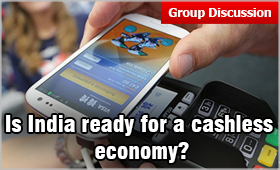
According to the website of cashless India, the Digital India programme is a flagship programme of the Government of India with a vision to transform India into a digitally empowered society and knowledge economy. “Faceless, Paperless, Cashless” is one of professed roles of Digital India.
The ambitious mission of government of India to drive India towards a cashless economy was boosted with the announcement of demonetization on November 8, 2016.
Also Read
What is a cashless economy?
A system where no physical cash is in circulation is a cashless system. Payments are made through credit and debit cards, bank electronic fund transfers or virtual wallets.
Benefits:
Yes, India is ready for a cashless economy.
The above mentioned data clearly represent a shift towards a cashless economy.
The smart phone revolution has led to the emergence of e-commerce, m-commerce and other services, including app-based cab aggregators, who encourage digital payments for use of various services. The value added services such as cash back, bill payment facilities, loyalty points, rewards and ease of use have resulted in surge of such digital platforms. These developments have given rise to a modern payment model.
Hurdles in making India a cashless economy
Also Check Latest Group Discussion GD Topics
Exam 2024 Notification